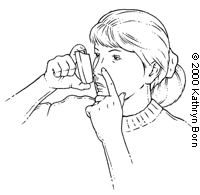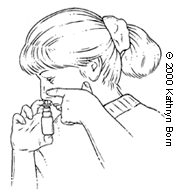
Am Fam Physician. 2000;62(12):2695-2696
Types of nasal sprays
Nasal sprays come in two different kinds of containers: pressurized canisters and pump bottles.
Steps for using a pressurized canister
Gently blow your nose to clear it of mucus before using the medicine.
Make sure the canister fits snugly in its holder. Shake the canister several times just before using it.
Keep your head upright. Breathe out slowly.
Hold your nasal spray canister as shown in the drawing to the right. Use your finger to close the nostril on the side not receiving the medicine.
Press down on the canister as you begin to breathe in slowly through your nose. Repeat these steps for the other nostril. If you are using more than one spray in each nostril, follow steps 2 through 5 again.
Try not to sneeze or blow your nose just after using the spray.

Steps for using a pump bottle
Gently blow your nose to clear it of mucus before using the medicine.
Remove the cap. Shake the bottle. The first time you use the pump spray each day, you may have to “prime” it, squirting a few times into the air until a fine mist comes out.
Tilt your head forward slightly. Breathe out slowly.
Hold the pump bottle with your thumb at the bottom and your index and middle fingers on top. Use a finger on your other hand to close your nostril on the side not receiving the medicine (see the drawing below).
Squeeze the pump as you begin to breathe in slowly through your nose. Repeat these steps for the other nostril. If you are using more than one spray in each nostril, follow steps 2 through 5 again.
Try not to sneeze or blow your nose just after using the spray.

Helpful hints
Remember, it may take up to two weeks of using a nasal spray before you notice the full effects.
If you are using a pressurized canister, wash it at least once a week.
Be sure you can sniff air through each nostril before spraying, otherwise the medicine will be wasted because it will not go deep into the inside of your nose.
Aim straight. Point the nozzle of the nasal spray container toward the back of your head. If you don't spray straight, you will waste the medicine and may cause more irritation in your nose.
If the pump spray is used correctly, the spray should not drip from your nose or down the back of your throat.
If your nose hurts, if you begin to have nosebleeds or if the inside of your nose stings, stop using the spray for one to two days. Sometimes it helps to use an over-the-counter saline nose spray such as SalineX, Ocean Nasal Mist or NaSal just before you use your regular medicine.
If you have nosebleeds, stop using the medicine for a few days and use a saline nasal spray instead. You can also use a cotton swab to spread a thin layer of petroleum jelly inside your nose right after using the saline spray. If the bleeding or irritation continues, talk to your doctor.
Use your medicines just the way your doctor tells you. Most nasal sprays work best when used regularly and consistently.
Keep your medicine away from sunlight.